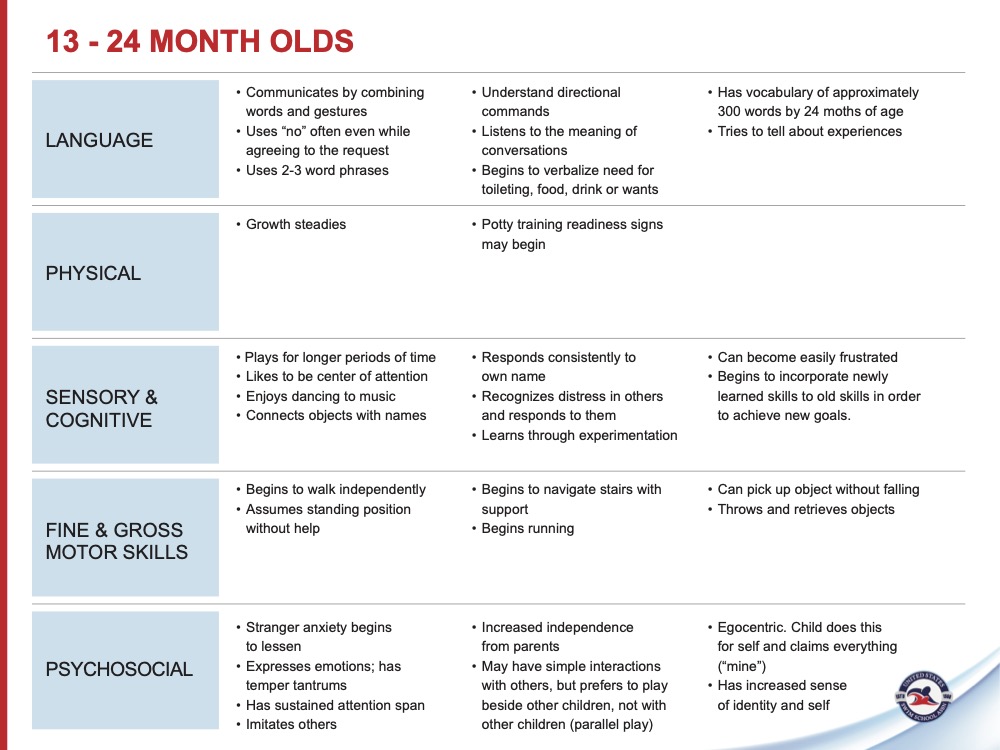WELCOME everyone! Enter the Pool and Gather in a Circle. Greet each adult/child pair and take time to allow babies and caregivers to adjust to the water. Introduce yourself, talk about what an amazing journey this will be with the caregiver and the baby. Demonstrate the Little Harbor Hold. Caregivers lengthen their arms to support their student under the armpits. Allow babies to explore the feelings of buoyancy and balance with support and you encourage caregivers to support as low in the water as possible so babies can learn to stabilize themselves (parents may need to bend their knees slightly to achieve this).
Welcome Song in Little Harbor. Gather parents into a circle and Talk To The Group. Ask the group if they have any questions about having their babies in the water and what they are most excited to gain from the class! Sway back and forth in little harbor while parents and infants get adjusted and relaxed. Next, sing the song and encourage the Parents to sing and splash along.
Noodle Fountain in Front Support. Have parents walk backward under the noodle fountain so that they can see the facial cues of their baby while the fountain lightly washes over them. While they move in a circular pattern hold the noodle up against the jet to create a fountain for them to pass under. Coach parents with walking slowly under the fountain and looking for the natural reaction of their baby as the water pours over their face. After a few cycles you should notice that the student is prepared and simply closes their eyes and mouth when under the water. Be sure to move the fountain around and wash the water from the back of the head to the front as it is less intimidating.
Elevators/Introduction to Submerging. During the initial introduction of learning breath control, submersions of young children, over 6 months, must be brief (approximately three seconds) and few in number (no more than six per lesson). Once the child can consistently initiate the submersions AND can demonstrate competent breath control, submersions can become longer and more frequent.
Gather parents and stand in a circle. Instruct parents to support the child under the arms facing the center of the circle. The cue is count 1- 2 – 3 then lift up and lower under. Submerging is not necessary each time, but try at least once. Practice a few times.
For More Advanced Students; Once fully submerged, encourage parents to release the child and allow them to float back to the surface. The release allows movement in a vertical position which reinforces the water’s lifting force.
Tips for Submerging
- Submerge the baby completely so that their entire body is underwater
- Keep the movement slow and at an even pace. Encourage the parent not to press them under or pull them up quickly
- Smiles, praise and eye contact from parent to baby then they resurface
Back Float Introduction and Practice. There are a variety of supporting positions that can be used for back floats but keep the following tips in mind:
- Hold with relaxed fingers, hands, and shoulders.
- Make good eye contact with the baby by leaning over and looking down.
- Aim to keep the ears in the water and gently sway back and forth.
- Let the water do the work and use as little support as possible
Back float with Mirrors. Encourage parents to support their children on their backs and tip toe around the pool in a circle. Either holding the big mirror up or allowing parents to hold the small mirrors, practice back floating.
Blast Offs on Front and Back. Instruct parents to support children on front by holding under the chest with their feet against the wall. Countdown 3 – 2 – 1 BLAST OFF, babies push off the wall and parents tip toe across the space moving from the ropes and back. Repeat this activity times on the front then assist parents with supporting on the back for a few more blast offs. Use the supporting techniques that were practiced earlier. TIP; Placing a target on the wall for each parent/baby (such as a colored cone) will help with spacing during the blast offs and direction on the way back. Encourage parents to pause on the way back from the rope and cue students to submerge on their way to the wall. It helps to place a mirror on their target to reach for.
Fishes in the Ocean. Parents support babies in a seated position on the edge of the pool. Explain to parents that if that now is the chance to submerge gently under their water after the three count. Note; When babies are first learning to submerge it is appropriate to take them under the water for up to 3 seconds and the maximum number of submersions per class is 6.
Wheels on the Bus. Gather students and parents into a circle and float some toys in the center of the circle. Wrap up the class with any announcements, then encourage parents to follow along with the movements of the yellow bus as you move around the pool one last time.
- Noodles
- Small Floating Mirrors
- Gecko and Turtle Boards
- Large Mirror
- Bus
- Squirt Cars








